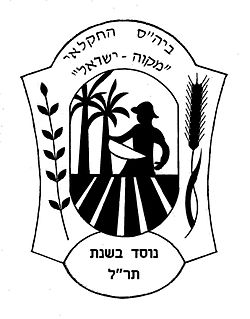Mikveh Israel
| Mikveh Israel | |
|---|---|

|
|
| type of school | Agricultural school |
| founding | 1870 |
| place | Cholon |
| district | Tel Aviv |
| Country | Israel |
| Coordinates | 32 ° 1 '47 " N , 34 ° 46' 57" E |
| Website | www.mikveisrael.org.il |
Mikveh Israel (מקוה ישראל) is the oldest Jewish agricultural school in Palestine . It is located in the north of the city of Cholon .
In addition to its educational role, the school also serves as a research center.
Surname
The Hebrew name of the school is taken from the book of the biblical prophet Jeremiah ( Jer 14.8 EU ); ( Jer 17,13 EU ) and means "hope of Israel".
history
Mikveh Israel was founded in 1870 on the initiative of Charles Netter . Netter was of the opinion that the children of Israel should be taught to farm in order to improve the situation of the Jews. The Ottoman government provided him with an area of 3000 dunams of land.
In 1898 Kaiser Wilhelm II visited the school on his Palestine trip, where he was greeted by Theodor Herzl .
From the late 1930s until the Israeli War of Independence , Mikveh Israel was an important base of the Hagana .
literature
- Alex Carmel: «Mikveh Israel» - «Hope» or «Gathering Israel» . In: Heiko Haumann (Ed.): "... I founded the Jewish state in Basel". The First Zionist Congress of 1897. Causes, Significance, Topicality . Karger, Basel 1997, ISBN 3-8055-6491-0 , p. 50.
Web links
Individual evidence
- ↑ Alex Carmel: "Mikveh Israel" - "Hope" or "Collection of Israel" . In: Heiko Haumann (Ed.): "... I founded the Jewish state in Basel". The First Zionist Congress of 1897. Causes, Significance, Topicality . Karger, Basel 1997, p. 50.
- ↑ Zeev Sadmon: The establishment of the Technion in Haifa in the light of German politics, 1907-1920 . Saur, Munich 1994, ISBN 3-598-23222-5 , p. 34.
- ↑ Michal Kaddar: "Far and beyond". The story of Gershon Kaddar . Ramat Gan 2012, p. 10.
